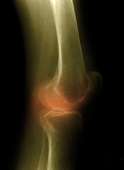Keep moving to ease pain of knee arthritis, review says

(HealthDay)—Adults with painful osteoarthritis of the knee should turn to exercise—aerobic, aquatic or strength training—as a good nonsurgical way to ease their pain and improve their functioning, a new review suggests.
To reach this conclusion, Dr. Tatyana Shamliyan, a senior research associate at the University of Minnesota, and her colleagues reviewed 193 studies that were published between 1970 and 2012.
"Several guidelines recommend nondrug treatment, including exercise, electrical stimulation, tai chi and esthetics," Shamliyan said. Her team analyzed the evidence and came up with results that were sometimes at odds with those guidelines.
They looked at how the therapies affected pain, functioning and disability.
"Based on the analysis, we can't conclude sustained benefit with tai chi, manual therapy or massage, or transcutaneous electrical [nerve] stimulation," she said.
The electrical stimulation reduced pain, she found, for very short time periods, less than six weeks. Over time, the pain actually got worse, she noted.
The investigators found few physical therapy interventions worked to reduce pain or improve functioning or levels of disability.
Shamliyan said it's important for those with knee pain from osteoarthritis—the "wear-and-tear" form—get a prescriptive exercise program of aerobics, aquatics or strength training from a physical therapist.
The research is published in the Nov. 6 issue of the Annals of Internal Medicine.
In the analysis, the researchers also found that perseverance counted. "We found some evidence that adherence, compliance with the exercise recommended was associated with better outcomes," she said.
However, the study authors did not find good evidence that more intense exercise was any better than moderate exercise.
The U.S. Agency for Healthcare Research and Quality funded the research.
Osteoarthritis of the knee affects about 28 percent of those older than 45 in the United States, the study authors said, and 37 percent of those over 65.
Nonsurgical treatments are aimed at reducing or controlling pain, helping physical functioning, preventing disability and improving quality of life.
The findings are no surprise to Dr. Benjamin Bengs, an assistant professor of orthopedic surgery at UCLA Medical Center, Santa Monica, and the University of California, Los Angeles, David Geffen School of Medicine.
"There is evidence to show that physical therapy, aerobic and aquatic exercise and strength training all improve quality of life," he said.
The researchers also showed that certain therapies were not effective, Bengs noted, although he would not discount them so quickly. "Given the potential for placebo effect, I would not rule out these [other treatments]," he added.
Often, Bengs said, his patients will be convinced a treatment that has no science to back it up is helping them. If it does, and it's not harmful, he doesn't see a problem.
He did suggest that some of the nonsurgical treatments work better when done in tandem with surgery.
And, Bengs agreed that people do better when they adhere to the exercise program prescribed for them.
Both Bengs and Shamliyan also advised maintaining a healthy weight to improve knee pain.
More information:
To learn more about knee pain, visit the
target="_new">U.S. National Library of Medicine.
Copyright © 2012 HealthDay. All rights reserved.

















